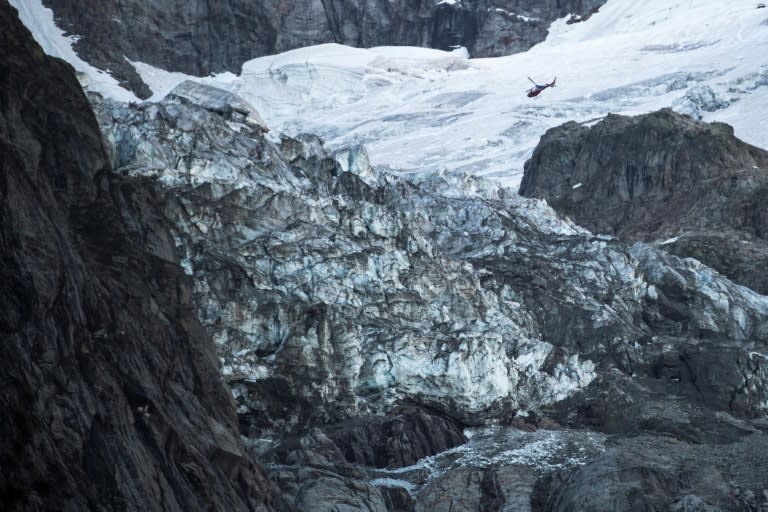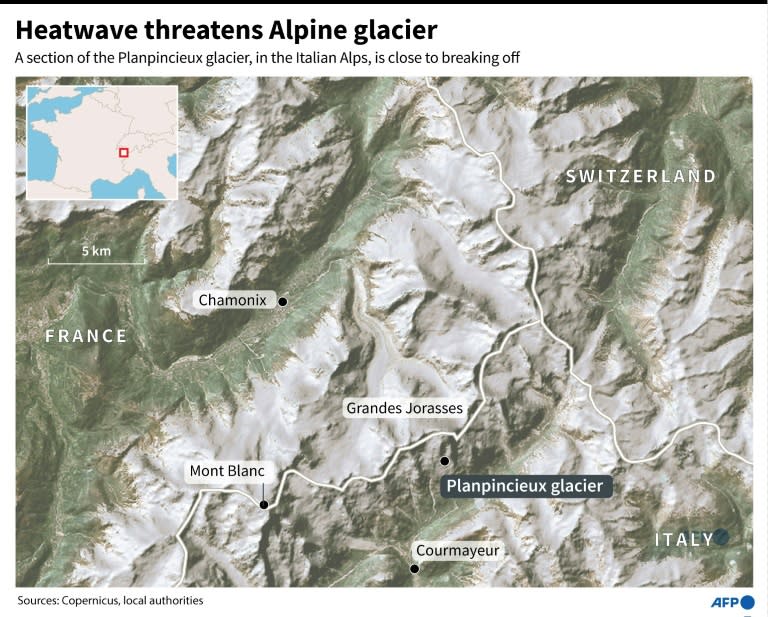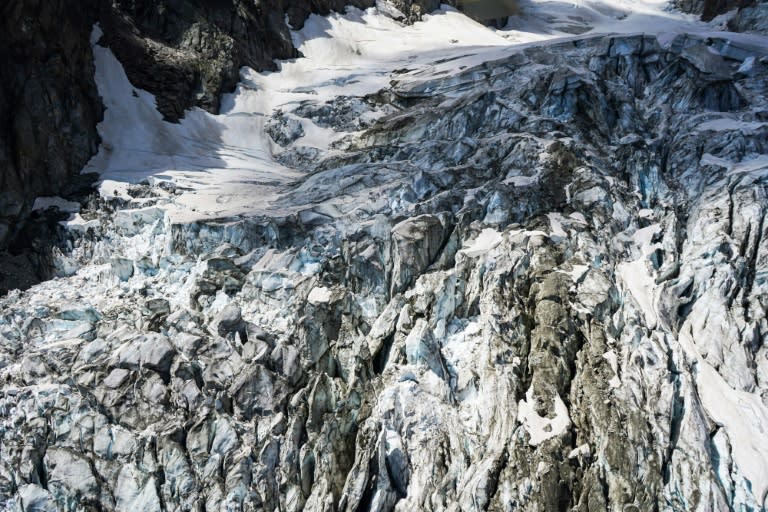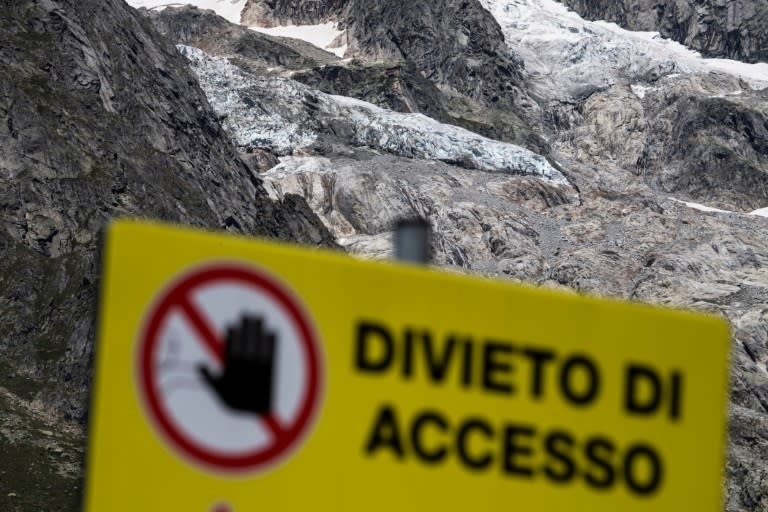IT SNOWED
During a helicopter flypast, an AFP reporter saw a gaping chasm on the lower part of the Planpincieux, from which two cascades of water flowed towards the valley
Andrea BERNARDI, AFP•August 8, 2020


Slight improvement' in melting glacier threatening Italy resort
The threat that a massive chunk of glacier loosened by soaring temperatures could collapse near an alpine resort on the Italian side of the Mont Blanc mountain range has slightly eased, a local mayor said Saturday.
Climate change has been increasingly melting the world's glaciers, creating a new danger for the town of Courmayeur, a resort community in Italy's Aosta Valley region, near the French border.
The town was put on high alert on Wednesday as a block of ice estimated at about 500,000 cubic metres -- the size of the Milan cathedral, one official said -- from the Planpincieux glacier risked falling and threatening homes.
A "red zone" at the base of the slope was also evacuated, with 20 residents and around 55 holidaymakers moved from the area.
But Courmayeur mayor Stefano Miserocchi said Saturday that things were looking up.
"We are in a phase of slight improvement, the situation is a little better," he told AFP.
"However we have not yet returned to the situation before the closure," he added
"The emergency measures remain the same: evacuation of the inhabitants, and the closure of the road to Val Ferret," a small valley normally busy with tourists at this time of year.
Some locals were dismissive of the closure, lamenting that it further affected a tourism season already hit by coronavirus measures.
However Mayor Miserocchi said it was "urgent and vital" to move people directly in the path of a potential ice fall, as more scorching temperatures are forecast over the coming days.
Ludovic Ravanel, a researcher at the University of Savoie Mont Blanc who studies glaciers and rockfalls in the Alps, defended the decision to evacuate the area.
"We cannot leave people under the threat of such an avalanche of ice," he told AFP.
- Global warming link 'obvious' -
Aosta Valley natural risk management director Valerio Segor said the situation was "especially delicate" because the heat "upsets the water level between the ice and the rock, and in turn the stability of the glacier."
He said the problem was "that not enough water can escape, it stays under the glacier like a bubble and risks lifting it up" -- which could tip its most fragile section to tumble into the valley, Segor told AFP earlier in the week.
But Miserocchi said Saturday that "the circulation of water under the glacier has resumed... it was this point that worried us a lot".
During a helicopter flypast, an AFP reporter saw a gaping chasm on the lower part of the Planpincieux, from which two cascades of water flowed towards the valley, as it hung from the mountainside like a gigantic block of grey polystyrene.
Researcher Ravanel said that Planpincieux's "link with global warming is obvious".
"A particularly strong glacial retreat over the past three decades, combined with increasingly frequent heatwaves, explains the current situation," he said.
There are more than 4,000 glaciers -- vast, ancient reserves of ice -- dotted throughout the Alps, providing seasonal water to millions and forming some of Europe's most stunning landscapes. But they are under severe threat from climate change.
hba/glr/dl/bp
Alpine glacier in Italy threatens valley, forces evacuations
Associated Press•August 7, 2020
Italian glacier at high risk for collapse
ROME (AP) — Experts were closely monitoring a Mont Blanc glacier on Friday, a day after they evacuated 75 tourists and residents amid fears the glacier could soon break apart and crash into a popular Italian Alpine valley.
Valerio Segor, a glacier expert in Valle d’Aosta, a region in northwestern Italy, told reporters on Friday that the next 72 hours were critical for the Planpincieux Glacier, which lies under a massif on the Italian side of Mont Blanc, the highest mountain in the Alps.
Those forced to evacuate came from homes and holiday lodgings in the Ferret Valley in the shadow of the glacier. Tourists on Friday were barred from entering the scenic valley.
The glacier’s size has been likened to that of a soccer field under a 80-meter (265-foot) high mass of ice. Abrupt shifts in temperature from hot to cold to hot again are being blamed for the precarious state of the glacier, which Segor says has a stream of water running beneath it.
The glacier's state has been monitored since 2013. Last year saw similar concerns, but the glacier held on to its grip on the mountain at 2,600-2,800 meters (8,500-9,200 feet) of altitude.
Lately, Planpincieux has been creeping downward at the rate of about 80-100 centimeters (32-40 inches) each day, Segor said.
The Corriere della Sera newspaper quoted glacier expert Fabrizio Troilo as saying there is “the danger it could give way in an instant.”
Corriere said an Alpine refuge was still open for climbers who come from the French side of Mont Blanc, which is known in Italy as Monte Blanco.
___
Follow all AP coverage of climate change issues at https://apnews.com/Climate.
Italian valley still in 'red zone' as Mont Blanc glacier threatens collapse
Anahide MERAYAN, AFP•August 7, 2020


Italian valley still in 'red zone' as Mont Blanc glacier threatens collapse
75 people have been evacuated from the valley below the glacier
An Italian alpine resort remained on high alert Friday over fears a vast chunk of a glacier on the slopes of the Mont Blanc massif could plummet in high temperatures.
"No one gets through! No cars, bikes or pedestrians," was the message at a checkpoint where an automatic barrier and two guards blocked the small tarmac road snaking up into a lush valley below the Planpincieux glacier, not far from the town of Courmayeur and the Italian-French border.
But the blockade has largely been greeted with contempt by the locals, one of whom told AFP "it's a joke".
The huge ice block measuring around 500,000 cubic metres -- "the size of Milan cathedral or a football pitch covered in ice 80 metres (260 feet) thick" according to an official -- could yet break free of its perch about 2,600 to 2,800 metres above sea level.
Late Wednesday, authorities ordered the evacuation of a "red zone" at the base of the slope for at least 72 hours, so far moving just 75 people -- around 20 locals and the remainder holidaymakers.
At this time of year, the small Val Ferret valley now blocked off is usually busy with tourists heeding the call of the mountains.
Located in the Aosta Valley region, the spot is not far from where a vital road tunnel pierces the Alps between France and Italy.
But the "red zone" is at least four kilometres from the tunnel entrance, while tourists could still be seen strolling through the streets of Courmayeur.
It was "urgent and vital" to move people directly in the path of a potential ice fall, Courmayeur mayor Stefano Miserocchi said, highlighting an "elevated state of alert" during the 72-hour evacuation.
The coming three days are expected to bring especially high temperatures as much of Europe sizzles under a heatwave.
- 'Delicate situation' -
There are more than 4,000 glaciers -- vast, ancient reserves of ice -- dotted throughout the Alps, providing seasonal water to millions and forming some of Europe's most stunning landscapes. But they are under severe threat from climate change.
A study last year by Swiss scientists found that Alpine glaciers could shrink between 65 and 90 percent this century, depending on how effectively the world can curb greenhouse gas emissions.
At Planpincieux this week, "it's an especially delicate situation because (the temperature) upsets the water level between the ice and the rock, and in turn the stability of the glacier," Aosta Valley natural risk management director Valerio Segor told AFP.
"Our problem now is that not enough water can escape, it stays under the glacier like a bubble and risks lifting it up" -- which could prompt its most fragile section to tumble into the valley, Segor added.
Last autumn, another section of ice from the Planpincieux glacier threatened to collapse, prompting road closures in the area, and heightened surveillance has since been introduced.
In Courmayeur, as in the small neighbouring commune of La Palud, leading to Val Ferret, the evacuation came as an unwelcome surprise, arousing criticism from residents and tourism professionals, worried about the impact on their activity.
In this typically Alpine hamlet, wooden chalets with slate roofs and balconies festooned with pink geraniums and greenery nudge up against hotels and restaurants which advertise their inviting "mountain menu".
"I looked at where the glacier was, where the danger was. It doesn't affect the centre of Courmayeur at all so we continued the visit", says Loic Hamelin, a Parisian tourist who came for the day with his family.
- 'It's a joke' -
The threat does not appear to have put off the walkers for an instant as they bustle through the streets with backpacks and boots to start a trail.
"It's a joke," says Rocco, owner of a hotel in La Palud.
"Every year, they (the local authorities) do the same thing to us. After the COVID-19 epidemic, it's a new disaster for tourism.
"We have been receiving calls from worried customers asking if they should cancel their reservation. But there is absolutely no problem!"
Another hotelier in the area, Ludovico Colombati, was equally dismissive after having to evacuate his house, which is "the closest to the glacier", just under two kilometres away.
"We live in the mountains, so there is always a risk. But in this case, it is very, very, very low," says Colombati, whose family has lived in the valley for four generations.
"With climate change, the hot summer, the glacier moves, blocks are detached, it's normal," he said, criticising the "psychosis" of administrators "who cover themselves for fear of having to assume the slightest responsibility".
"Several times a day, my ears hear the glacier being triggered... That's life in the mountains, especially when you live at the foot of a wall.
"The day after tomorrow, it will be all open," he says.
hba/tgb/ach/bsp/pvh
Mont Blanc: Homes evacuated amid fears glacier might collapse
Vincent Wood, The Independent•August 6, 2020

dozen people have been evacuated in northwestern Italy as a huge chunk of the glacier in the Mont Blanc massif threatens to break off due to high temperatures: AFP via Getty Images
Residents of Italy’s Aosta Valley have been told to evacuate their homes over fears that a portion of a Mont Blanc glacier the size of a football pitch could collapse over the region.
Some 75 people were evacuated from the town of Courmayeur after the Safe Mountains Foundation sounded the alarm over 10,000 cubic metres of ice which could fall from the Planpincieux glacier in the coming days.
The glacier’s degradation has caused disruption and death in the past – killing an elderly couple near Courmayeur in 2018 when their car was swept from the road in an event that prompted a mass evacuation of the surrounding area.
Around 60 tourists and 15 residents are now reported to have been removed to safety, while those in the Val Ferret region have been told to stay only if they have adequate supplies of essentials including food to last three days.
Safe Mountain Foundation glaciologist Fabrizio Troilo told La Stampa there was “a risk of instant collapse”.
The region was also evacuated in 2019 due to the threat posed by the glacier, but experts say the portion now at risk of breaking off is twice the size as last year.
Mr Troilo said there is “now there is an enormous body of ice leaning against the rock”.
Mont Blanc, Europe’s second highest peak, is home to some 4,000 glaciers, of which the Safe Mountains Foundation monitors 184 for signs of glacial melt.
French president Emmanuel Macron has called the melting of glaciers around the mountain range, which straddles Italy, France and Switzerland, “irrefutable proof of global warming and climate change and the toppling of an entire ecosystem”.
Meanwhile scientists at non-profit research institute CREA Mont Blanc have warned that rising temperatures mean that “since 1850, glaciers in the Alps have lost between 30 and 40% of their surface area and half of their volume”.
Read more
Scientists warn of rapid melting of Antarctica’s ‘Doomsday glacier’
Residents of Italy’s Aosta Valley have been told to evacuate their homes over fears that a portion of a Mont Blanc glacier the size of a football pitch could collapse over the region.
Some 75 people were evacuated from the town of Courmayeur after the Safe Mountains Foundation sounded the alarm over 10,000 cubic metres of ice which could fall from the Planpincieux glacier in the coming days.
The glacier’s degradation has caused disruption and death in the past – killing an elderly couple near Courmayeur in 2018 when their car was swept from the road in an event that prompted a mass evacuation of the surrounding area.
Around 60 tourists and 15 residents are now reported to have been removed to safety, while those in the Val Ferret region have been told to stay only if they have adequate supplies of essentials including food to last three days.
Safe Mountain Foundation glaciologist Fabrizio Troilo told La Stampa there was “a risk of instant collapse”.
The region was also evacuated in 2019 due to the threat posed by the glacier, but experts say the portion now at risk of breaking off is twice the size as last year.
Mr Troilo said there is “now there is an enormous body of ice leaning against the rock”.
Mont Blanc, Europe’s second highest peak, is home to some 4,000 glaciers, of which the Safe Mountains Foundation monitors 184 for signs of glacial melt.
French president Emmanuel Macron has called the melting of glaciers around the mountain range, which straddles Italy, France and Switzerland, “irrefutable proof of global warming and climate change and the toppling of an entire ecosystem”.
Meanwhile scientists at non-profit research institute CREA Mont Blanc have warned that rising temperatures mean that “since 1850, glaciers in the Alps have lost between 30 and 40% of their surface area and half of their volume”.
Read more
Scientists warn of rapid melting of Antarctica’s ‘Doomsday glacier’
No comments:
Post a Comment